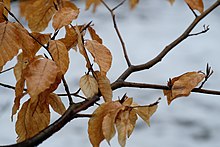Marcescence
Marcescent leaves may be retained indefinitely and do not break off until mechanical forces (wind for instance) cause the dry and brittle petioles to snap.
[9] The evolutionary reasons for marcescence are not clear, theories include: protection of leaf buds from winter desiccation, and as a delayed source of nutrients or moisture-conserving mulch when the leaves finally fall and decompose in spring.
[10] Many palms form a skirt-like or shuttlecock-like crown of marcescent leaves under new growth that may persist for years before being shed.
[16] One possible advantage of marcescent leaves is that they may deter feeding of large herbivores, such as deer and moose, which normally eat the twigs and their nutritious buds.
[18] Species that display marcescence, such as beech and oak, have adapted to retaining their leaves for prolonged periods to thrive in difficult growing media.
[25] Palm genera with taxa having marcescent leaf bases and attracting epiphytic fig growth include Attalea, Butia, Caryota, Copernicia, Elaeis, Hyphaene, Livistona, Phoenix, Sabal, and Syagrus.



